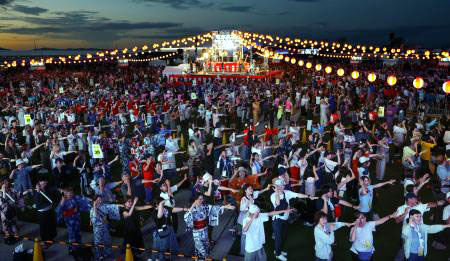♭♯♭ 風の盆 ♭♯♭
今年も『風の盆』を迎える季節になりました。
富山県富山市八尾(やつお)地域で毎年9月1日から3日にかけて開催される「おわら風の盆」は、約300年の歴史を誇る民謡と踊りの祭典です。山あいの静かな町に、秋の気配とともに哀愁を帯びた胡弓や三味線の音色が響き渡り、編笠を深くかぶった男女の踊り手たちが、夜の町並みを静かに流して踊ります。その姿は幻想的で、観る者の心を深く揺さぶります。
踊りは男女で異なり、男性は力強くしなやかに、女性は優雅で繊細に舞い、いずれも自然への畏敬と人々の祈りが込められています。踊り手たちは町の通りを練り歩きながら、豊作や家内安全を願い、訪れる人々に静かな感動を届けます。
八尾の町は石畳の坂道や格子戸の町家が並び、祭りの期間中はぼんぼりの灯りに照らされて、まるで時が止まったかのような風情が漂います。観光客はその幽玄な雰囲気に魅了され、毎年全国から多くの人々が訪れます。
「風の盆」は単なる祭りではなく、風とともに生きる人々の心の響きであり、自然と人間の調和を象徴する文化遺産です。静けさの中に込められた情熱と祈りが、現代に生きる私たちにも深い余韻を残してくれます。
Owara Kaze no Bon is a traditional folk event held annually from September 1st to 3rd in the Yatsuo district of Toyama City, Japan. With a history spanning over 300 years, this evocative festival marks the arrival of autumn and offers prayers for a bountiful harvest. As dusk falls, the quiet mountain town transforms into a stage of ethereal beauty. The melancholic strains of the kokyū (Japanese bowed lute) and shamisen echo through the narrow streets, guiding dancers who wear woven sedge hats low over their faces, moving gracefully in procession.
The dances—distinct for men and women—embody both strength and elegance. Male dancers perform with dynamic precision, while female dancers move with delicate poise, each step infused with reverence for nature and ancestral spirit. Their silent procession through the lantern-lit streets evokes a sense of timelessness, as if the town itself breathes in rhythm with the music.
Yatsuo’s historic townscape, with its stone-paved slopes and latticework houses, adds to the festival’s dreamlike atmosphere. Visitors from across Japan are drawn not by spectacle, but by the quiet intensity and emotional depth that Kaze no Bon offers. It is not merely a celebration, but a living expression of harmony between humanity and the natural world—a cultural legacy that continues to resonate deeply in the hearts of those who witness it.

